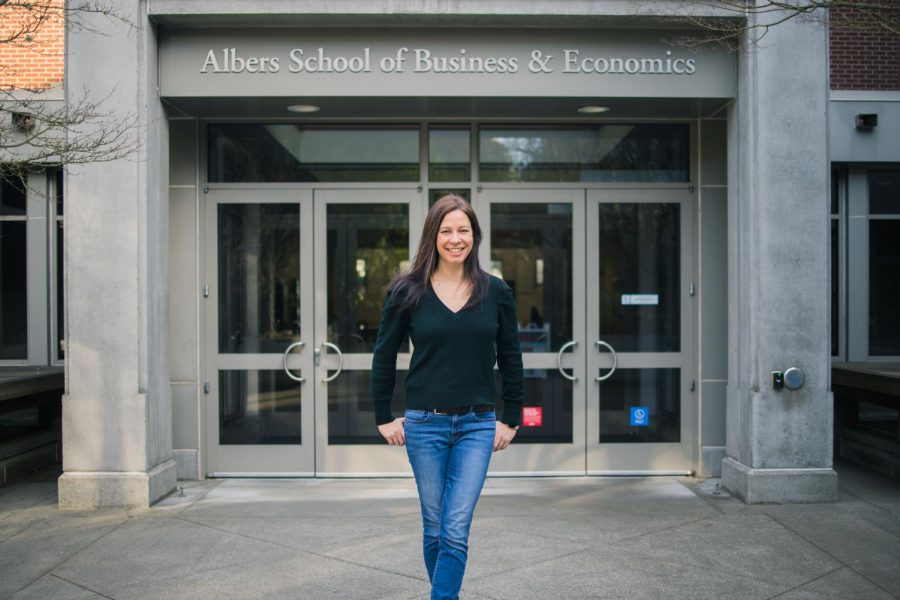Faculty Parents Juggling Challenges During COVID-19
Professor Lynn Hofstad outside Pigott
When Lynn Hofstad’s daycare shut down in March 2020, the Hofstad family not only had to radically upend their lives, they were forced to make additional payments to a daycare that (while theoretically still operating) was no longer doing anything of use.
“We had to keep paying, even though [my son] couldn’t go,” Hofstad, a professor in Seattle University’s Theology Department and the mother of a two-year-old boy, said.
Throughout the pandemic, Hofstad and her husband both had to work full-time jobs while taking care of a son who was too young to be left alone for more than a few minutes at a time. Hofstad described how she implemented convoluted teaching arrangements in order to try to keep as much of her day free for her son as possible.
Her struggles reflect those of many pandemic parents—long days filled with work, childcare and unforeseen blows to not only the checkbook, but to mental health as well.
In the fall of 2021, Hofstad found some relief with a new preschool and was able to settle back into a regular teaching schedule. The day after Seattle U returned to in-person instruction, the Hofstad family immediately received frightening news regarding their son.
“My family got an email that there was a [positive COVID-19] case in his class and school was closed for the rest of the week,” Hofstad said. “I had to go in person, and my husband had to take vacation time to be with our son.”
While students may have the flexibility to miss class due to COVID-19 related logistical difficulties, that same grace is often not afforded to professors. It puts Hofstad and other faculty members with children into an uncomfortable choice between their work and their family, a problem some professors grappled with before the additional challenge posed by the pandemic.
Maria Tedesco, a professor in Seattle U’s Matteo Ricci Institute and mother of two, had a similarly traumatic childcare experience. Pre-pandemic, her five-year-old was in daycare and her toddler was at home with her mother-in-law.
“The first quarter [of the pandemic] was just panic,” Tedesco said. “There were two parents, two children and one grandma stuck in the house together. We barely survived.”
When Tedesco and her partner returned to work, they were forced to hire a babysitter for their kids during the day. With a childcare rate of $25 an hour for eight hours a day, Tadesco described the impact on their family’s wallet as particularly brutal.
Faculty members expressed frustration with a common misconception about remote work—that online learning allows professors who work from home to take care of their children during the day. If a professor has younger kids, like Hofstad or Tedesco, they are unable to leave them alone to attend to work for any length of time. Childcare is not a partial commitment.
The last-minute communication from Seattle U’s administration regarding moving online compounded the struggle. Hannah Tracy is the mother of a seven-year-old girl and a professor in Seattle University’s English department.
“I understand that we’re making decisions in the middle of a pandemic,” Tracy said. “But better and earlier communication would certainly have been helpful.”
However, when administrators stepped up to offer extra assistance, professors were enormously appreciative.
“My experience with my department chair in particular has been very helpful, supportive and flexible,” Hofstad said. “She’s a great advocate and support for the faculty.”
This support matters enormously. Teaching online is a huge transition for faculty, and they currently have more to do than ever. Professors are expected to accommodate students who miss in-person class due to COVID-19 reasons, which frequently includes time commitments outside of regular work hours.
“The time I have to spend with my kid in the evenings is often taken up by a lot of administrative work that I’m doing because of COVID-19,” Tracy said.
Tedesco echoed the sentiment that it is difficult to carve out non-work time.
“There is a lot of working at night,” Tedesco said. “It’s been a recurring situation with all of the sicknesses, school closures and needing to take care of kids during the day.”
Hofstad, Tedesco and Tracy do not want to move back to online—all of them expressed a firm preference for in-person teaching. However, they ask for students and administrators to be mindful of the impacts of rapid changes on faculty members, especially for those who have childcare commitments.


